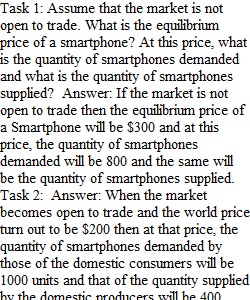


Q INTERNATIONAL TRADE IN-CLASS WORKSHEET 1 This question examines the market for smartphones. You will use the quantity demanded and the quantity supplied at different prices to identify the equilibrium price. Additionally, you will investigate the role of international trade when the world price is below the market equilibrium price. Below, you are provided with the quantity of smartphones demanded and supplied. This data is obtained from points on the demand and supply curves in the market for smartphones. Price (dollars) Quantity of Smartphones Demanded Quantity of Smartphones Supplied $150 1,100 200 $200 1,000 400 $250 900 600 $300 800 800 $350 700 1,000 Task 1: Assume that the market is not open to trade. What is the equilibrium price of a smartphone? At this price, what is the quantity of smartphones demanded and what is the quantity of smartphones supplied? Task 2: Assume that the market is open to trade and that the world price is $200. At this price, what is the quantity of smartphones demanded by domestic consumers and what is the quantity of smartphones supplied by domestic producers? Task 3: Assuming that the market is open to trade and the world price is $200, does this country import or export smartphones? How many? INTERNATIONAL TRADE IN-CLASS WORKSHEET 3 This question examines the market for bananas. You will use the quantity demanded and the quantity supplied at different prices to identify the equilibrium price. Additionally, you will investigate the role of international trade when the world price is below the market equilibrium price and analyze the impact of a tariff. Below, you are provided with the quantity of bananas demanded and supplied. This data is obtained from points on the demand and supply curves in the market for bananas. Price (dollars per pound) Quantity of Bananas Demanded (pounds) Quantity of Bananas Supplied (pounds) $ 2 18 8 $ 4 15 10 $ 6 12 12 $ 8 9 14 $10 6 16 Task 1: Assume that the market is not open to trade. What is the equilibrium price of a pound of bananas? At this price, what is the quantity of bananas demanded and what is the quantity of bananas supplied? Task 2: Assume that the market is open to trade and that the world price is $2. At this price, what is the quantity of bananas demanded by domestic consumers and what is the quantity of bananas supplied by domestic producers? Task 3: Assuming that the market is open to trade and that the world price is $2, does this country import or export bananas? How many? Task 4: Assume that the market is open to trade, the world price is $2, and the government imposes a tariff on imports of bananas of $2 per pound. At this world price and tariff amount, what is the quantity of bananas demanded by domestic consumers and what is the quantity of bananas supplied by domestic producers? Task 5: Assuming that the market is open to trade, the world price is $2, and there is a $2/pound tariff on bananas, does this country import or export bananas? How many? Task 6: When the government places a tariff on imports, do larger tariffs lead to more or less imports? Task 7: What is the maximum tariff that the government could impose in this banana market before domestic consumers would stop importing bananas?
View Related Questions